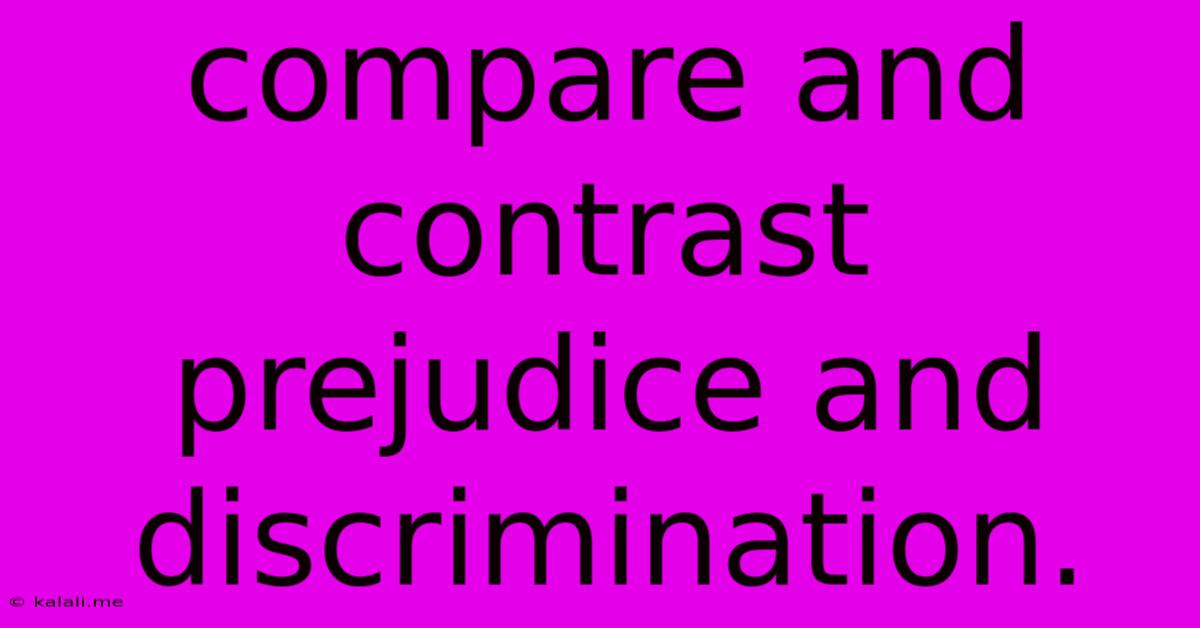Compare And Contrast Prejudice And Discrimination.
Kalali
Jun 15, 2025 · 3 min read

Table of Contents
Prejudice vs. Discrimination: Understanding the Difference
Meta Description: Prejudice and discrimination are often used interchangeably, but they are distinct concepts. This article explores the key differences between prejudice (a negative attitude) and discrimination (a negative action), providing examples to clarify the distinction. Learn how these concepts relate to social injustice and inequality.
Prejudice and discrimination are two terms frequently used in discussions about social justice and inequality. While often used interchangeably, they represent distinct concepts with different implications. Understanding the difference between prejudice and discrimination is crucial to effectively addressing and combating bias and injustice.
What is Prejudice?
Prejudice refers to preconceived judgments or opinions, often negative, about a group or its members. It's an attitude, a way of thinking, that involves forming an opinion before having all the facts or even encountering the individuals involved. Prejudice can be based on various characteristics, including race, ethnicity, religion, gender, sexual orientation, age, and socioeconomic status. It's rooted in stereotypes – oversimplified and often negative generalizations about a group of people. These stereotypes can lead individuals to perceive members of the target group as homogeneous, ignoring individual differences and unique qualities.
Key characteristics of prejudice:
- Cognitive component: Involves beliefs and stereotypes about a group.
- Affective component: Includes feelings and emotions like fear, anger, or dislike towards the group.
- Behavioral component: While not always directly manifested in action, it sets the stage for discriminatory behavior.
For example, someone holding a prejudiced belief that all members of a particular religious group are untrustworthy exhibits prejudice. This belief doesn't necessarily translate to immediate action, but it forms the foundation upon which discriminatory behavior might develop.
What is Discrimination?
Discrimination, on the other hand, is the action that stems from prejudice. It's the unequal treatment of individuals based on their group membership. Discrimination can manifest in various ways, both overt and subtle, impacting individuals' opportunities, access to resources, and overall well-being. It's the unfair or prejudicial treatment of people and groups based on characteristics such as race, gender, religion, or sexual orientation.
Key characteristics of discrimination:
- Action-oriented: It's the active manifestation of prejudice.
- Behavioral component: This involves overt actions, such as exclusion, denial of opportunities, or harassment.
- Can be individual or institutional: Discrimination can be perpetrated by individuals or embedded within systems and institutions.
For example, refusing to hire a qualified job applicant because of their race is an act of discrimination. Similarly, the systematic exclusion of certain ethnic groups from housing opportunities due to discriminatory policies is a form of institutional discrimination.
Prejudice and Discrimination: A Synergistic Relationship
While distinct, prejudice and discrimination are closely intertwined. Prejudice often precedes and motivates discrimination. However, it's important to note that prejudice can exist without leading to discrimination, and discrimination can sometimes occur without overt prejudice (perhaps due to systemic biases). For instance, someone might harbor prejudiced beliefs but choose not to act on them. Conversely, institutional structures can perpetuate discrimination even without individual actors consciously harboring prejudiced attitudes.
Combating Prejudice and Discrimination
Addressing prejudice and discrimination requires a multi-pronged approach, including:
- Education: Promoting awareness and understanding of bias and its impact.
- Legislation: Enacting and enforcing anti-discrimination laws.
- Individual responsibility: Challenging prejudice and discriminatory behavior whenever encountered.
- Systemic change: Addressing systemic inequalities that perpetuate discrimination.
By understanding the nuances between prejudice and discrimination, we can develop more effective strategies to combat bias and build a more equitable and just society. Both prejudice and discrimination are serious social issues that demand our attention and proactive measures to mitigate their harmful effects.
Latest Posts
Latest Posts
-
Which Of The Following Words Is Misspelled
Jun 16, 2025
-
What Are The Prime Factors Of 192
Jun 16, 2025
-
How Many Molecules Are In 2 Moles Of H2o
Jun 16, 2025
-
What Does The Area Under The Velocity Time Graph Represent
Jun 16, 2025
-
Which Mountain Range Separates France From Spain
Jun 16, 2025
Related Post
Thank you for visiting our website which covers about Compare And Contrast Prejudice And Discrimination. . We hope the information provided has been useful to you. Feel free to contact us if you have any questions or need further assistance. See you next time and don't miss to bookmark.